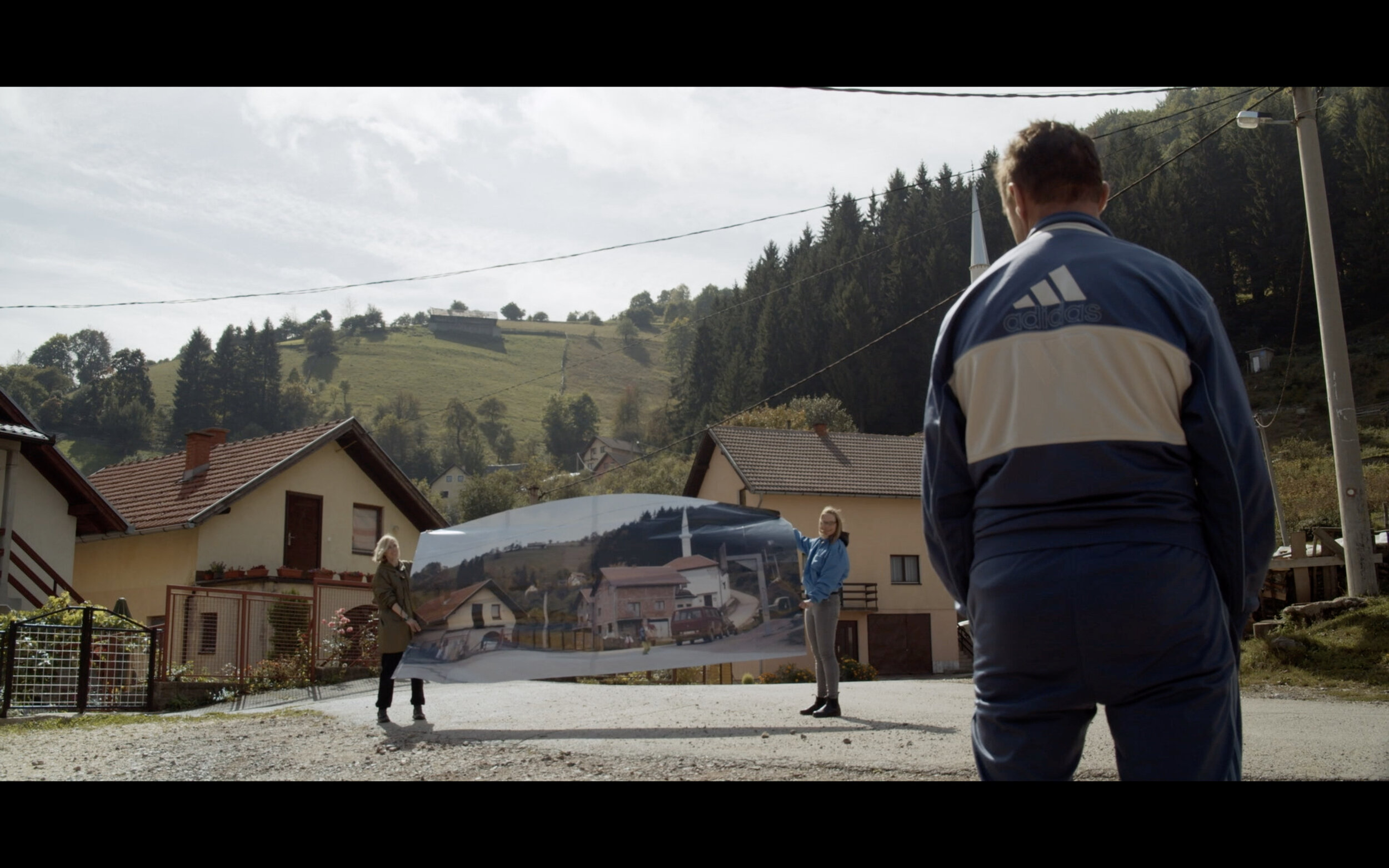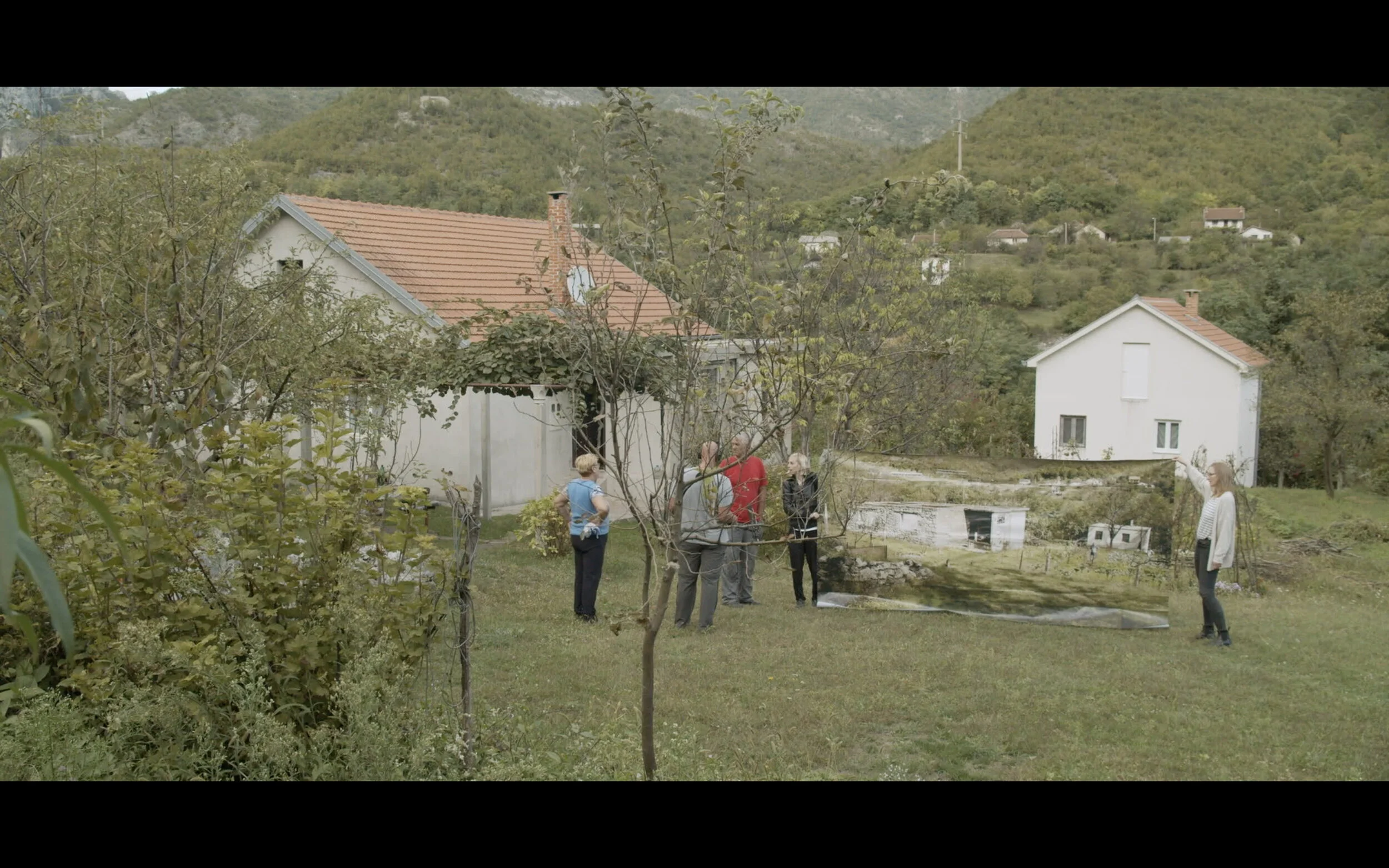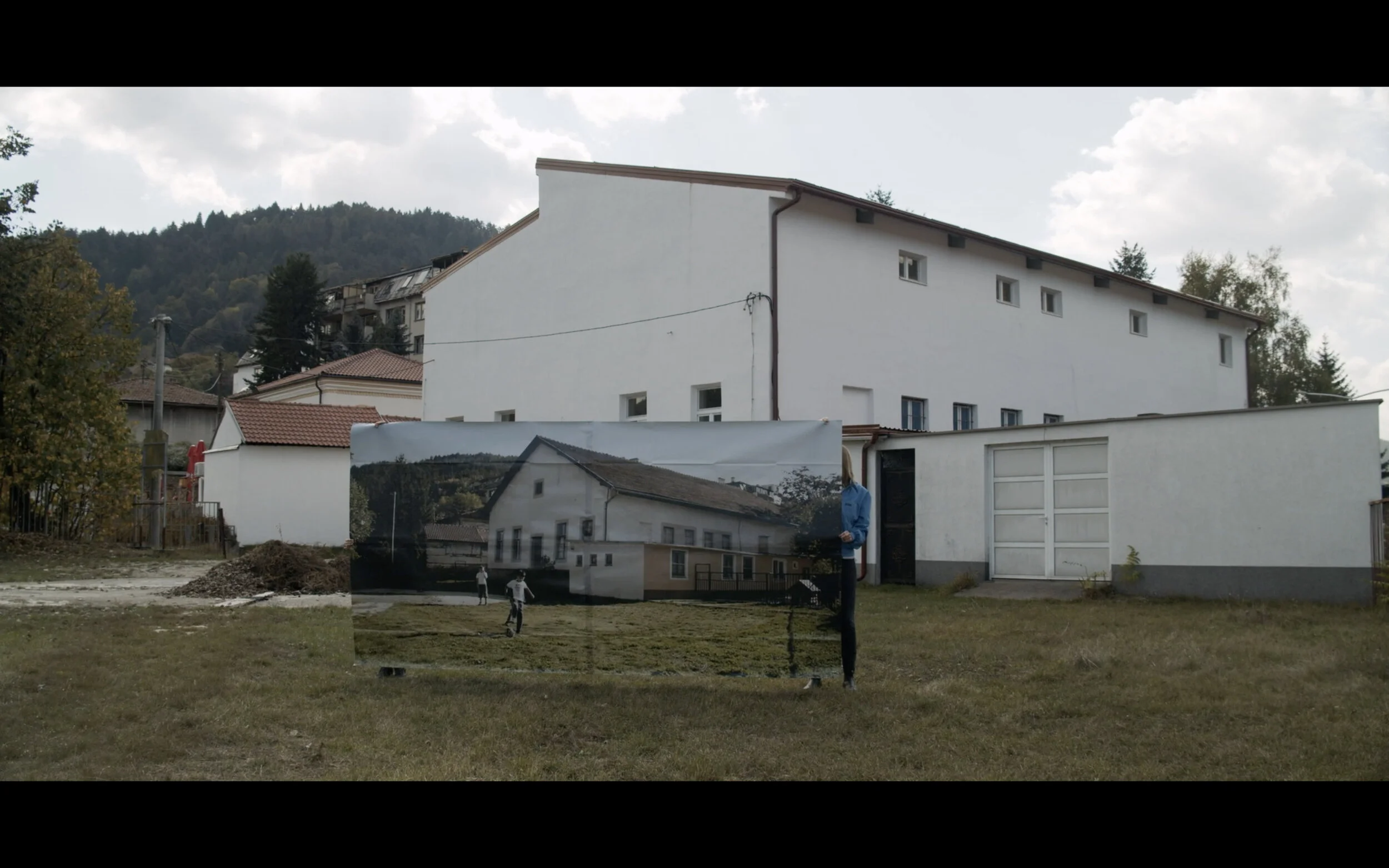WAS BLEIBT I ŠTA OSTAJE I WHAT REMAINS / RE-VISITED
Film, Germany / Austria / Bosnia and Herzegovina, 2020, 70 Min, 2/4K DCP, Engl sub.
(Berlinale Forum 2020)
Was bleibt I Šta ostaje I What remains / Re-visited © Clarissa Thieme
Films end. Biographies end. Life goes on. Can we break this law? Clarissa Thieme takes a stab at it. In "Was bleibt | Šta ostaje | What remains / Re-visited" (2020) she travels to certain cities and villages in Bosnia Herzegovina. She takes a single shot in each of the places where countless people have been raped, tortured, and murdered during the Bosnian War. Ten years ago, Thieme had been there already. "Was bleibt | Šta ostaje | What remains" (2009, 2010 world premiere at Berlinale) showed these places without accompanying words. Each of the images questioned: Does the location give testimony to the horror, or does it stay silent?
Ten years later everything is different, or is it? In each of the places Thieme and her film team unfold a life-size transparent with a still from the preceding film from 2010. Sometimes this comparison of ‘now and then’ is simply a silent act of recognition. At other times it sparks conversation. Some are evasive, some full of lived-through memories. Who died where, is one of the questions. Who left to build a new existence elsewhere; who stayed; who returned – are some of the other. Between the lines and between the images it becomes clear: these topics haven’t been processed yet. And, how could they? It is difficult enough to keep on living.
At the same time the filmic intervention prompts a reaction: In front of Thieme’s camera momentary public spaces arise. The old images provoke exchange. This exchange takes the form of what the reacting people are giving it. The film does not unravel a mystery – it is doing something mysterious: It dives into a space between remembrance and continuation and interlocks retrospection with the present. The void is everywhere. And Thieme’s film is never finished. On the contrary, it proves that there is a chance to act through film. To be continued. (Jan Verwoert)
Was bleibt I Šta ostaje I What remains / Re-visited © Clarissa Thieme
Was bleibt I Šta ostaje I What remains / Re-visited © Clarissa Thieme
Was bleibt I Šta ostaje I What remains / Re-visited © Clarissa Thieme
A radical simultaneity
A conversation with Clarissa Thieme about her film “What remains I Šta ostaje I What remains / Re-visited”
by Jan Verwoert
"What remains I Šta ostaje I What remains / Re-visited" is a follow-up of your film "What remains I Šta ostaje I What remains", which you also shot in Bosnia-Herzegovina but ten years ago. What was the starting point of your engagement with the Bosnian War?
The first film, from ten years ago, was a reaction to the fact that, despite all the information I had collected about the war in former Yugoslavia in the 1990s, I did not understand what actually happened there. This frightening discrepancy between knowledge and at the same time not understanding was my artistic starting point. I tried to create a cinematic experiential space that depicted this void in front of me like a shadow outline. There were some very aggressive reactions to this first quite silent film, which showed the war crime sites in their mundanity, lacking any comment. I was accused of portraying these places as beautiful and was told that I shouldn't have approached them as such at all. That surprised me. I found it interesting that some people react very aggressively to silence, but also to the fact that I simply dared to stay in these places. In former Yugoslavia, on the other hand, the silence and my lingering were received rather positively. After screening the film, many people told me about their personal war experiences. There the film was primarily an opener. For many it seemed to be a respite where there was suddenly room to think about what the film had to do with themselves and to be able to communicate this. In a way, the new film came out of this experience.
The empty space is not nothing. We have a setting, a background, a place where life has continued. Sometimes it is landscapes, sometimes it is cities. In other moments it is a small village community where you can hardly imagine that atrocities can happen in such a rural idyll. All of these things can be found in your images. Nevertheless, the term 'empty space' is correct. What is there, what is not there? It is a very full emptiness.
I would describe it as a radical simultaneity that inevitably overwhelms you if you let yourself into it - a simultaneity that has always existed. It is the normal, real madness. You may have this mediocre or normal life, and yet you have these traumatic aspects in there. The trauma cannot simply be put aside, but it is always there, even if we mostly choose to pretend that everything is neatly separate, as if one only started when the other was completed. The temporal levels, however, are always mixed up. There is a simultaneity of many things that do not fit together.
You refer to the weight of certain events in many of your cinematic, and also installation works, but you do not stylize the event in order to challenge anything?
In the shadow that the event casts on things, something else seems to be happening - something that one can’t understand in the event itself. That's why I'm looking for alternative ways to express it artistically. We are mostly interested in the event but hardly what it does to us and others. And it does something. It goes on. This is not a thing of the past with the first generation, or the second. I am interested in that. We and our lives are strongly shaped by these events, which we briefly address, but generally think have a beginning and an end, and when they're over, you put them in the history books. That's not how it works though.
This mixing of the timelines can be felt strongly in "What remains I Šta ostaje I What remains / Re-visited". You return to the places with billboard-sized film stills that show the places from ten years ago. That incites conversation. Some lead back to the atrocities of war, others evade it. The effort to keep life going is always an issue. And then people talk about where they found their dead relatives and who is still missing. There are very different urgencies overlapping, right?
I wanted to visit these places and people again, ten years after my first film. I was eager to know what bothers them now and what these places are filled with. I was interested in the whole spectrum from the beginning: the obvious, but also its periphery. If you put yourself in this position, the different urgencies arise automatically. Each of us consists of this kind of simultaneity that breaks every headline. When I shot the first film fifteen years after the war, public interest in Bosnia and Herzegovina had long since subsided. These headlines no longer existed anyway. It was only logical to pursue this in the new film with this long-term engagement. The first film was very observational and withdrawn. That no longer fit now. And it was clear to me that this time I would have to go into the frame myself. I was wondering how this can work without forcing what happens in it. I wanted to open a space where something can happen, but doesn't have to.
You work with very tense scenes. The first film has long shots. The risk is that nothing happens there. But in the long shots there is an incredibly intensified sensory perception. This is conceptually hard thought, but then very open filmically. In the new film you take the same camera position from ten years ago and go into the frame of today with a film still of the first film. It is a very conceptual, reflective gesture, but it becomes an action on the spot. What do you think about this interplay of hard, conceptual decisions and those moments that are open to experience and the perception that it creates in your films?
The concept of both films is not to control what happens, or have certainty that something will happen at all. I set a strong framework for both, but then left it to the situation. It is not easy for me to let go. This time I found it all the riskier because I didn't just want to watch. Interacting with local people was what I wished for the new film, but you cannot force encounters. You can be open to them. And then, you have to endure this openness. Because you may be disappointed. First of all, you give before you may get anything. You're there. You also do it at the risk of being alone. I was afraid of another thing, namely, that this performative approach could run past the people and places in a very snobby way. I was relieved to see that our performative set-up was accepted playfully. There was no right or wrong either. It was an offer no more and no less. Doing the film, I experienced how much listening, though not necessarily a guarantee people will speak of themselves, is its essential requirement. In the end, I was surprised that so many things happened. I could never have planned that. And I was very touched by how important it was to most people that I had been there ten years ago and now came back to ask how it was. From then on, everything was very easy.
With its bizarre character this action interrupts everyday life, but in the interruption, it gives people the freedom to respond to it how they want. Was it a deliberate conceptual decision that when you explain what you are doing, you do not immediately speak of returning to the theaters of war?
Yes. We're talking about coming back after ten years, leaving it up to people to refer to the war or just to comment on those ten years that lie between the images. I wanted to meet everyone where they were and hear what was on their mind that very moment. It was important to me to also leave it as it was, just like the places where there is only us with the image from ten years ago. When you listen to people or visit places, you have to accept what appears or does not. Maybe you should also trust that what doesn't appear tells something too, that this too is part of the conversation we have with each other.
Interview: Jan Verwoert, January 2020
Was bleibt I Šta ostaje I What remains / Re-visited © Clarissa Thieme
WAS BLEIBT I ŠTA OSTAJE I WHAT REMAINS / RE-VISITED
A film by Clarissa Thieme
Produced by Caroline Kirberg
Co-produced by Christine A. Maier
Director of photography Almir Đikoli (ASBH)
Assistance & performance Emina Kujundžić
Sound engineer Samir Hrković
Service production BiH Amira Lekić
Color correction I post production Till Beckmann
Sound design Christian Obermaier
Re-recording mixer Jochen Jezussek
Translation Tomislav Piplica
Graphic design Imke Schmidt-Sári
Danke I Hvala I Thank you I Nedim Alikadić, Thomas Arslan, Mouna Abou Assali, Ulrike Bruckner, Sabine Derflinger, Jasmina Đikoli, Otmar Džafetagić, Eldar Emrić, Iris Fedorischin, Daniel Freymüller, Rainer Fritz, Rebekka Garrido, Jozefina Gocman, Hasan Hasanović, Juliane Henrich, Jasmina Iftić, Ibrica Jasarević, Nihad Kreševljaković, Senada Kreso, Tanja Krone, Žarko Marić & family, Memorijalni Centar Srebrenica-Potočari, Tana & Nedim Mutevelić, Didem Pekün, Claudia Peters, pong film, Imke Schmidt-Sári, Elma Selman, Dunja Stamer, Kika Babić Svetlin, Leon Svetlin, Ulvija Tanović, Elma Tataragić, Traute Thieme, Udruženje Žene Stupnog Dola, Jan Verwoert, Die Werkstatt, Jasmila Žbanić
Supported by Kunstfonds Bonn





